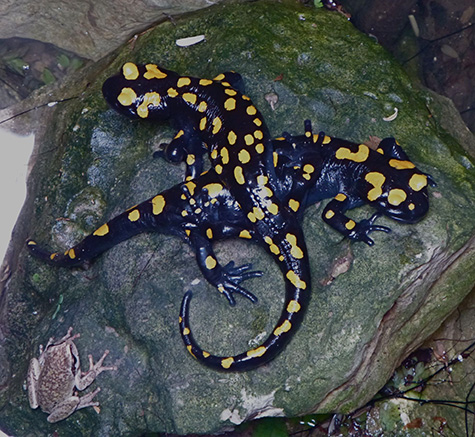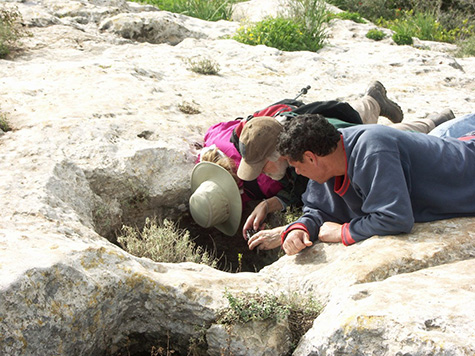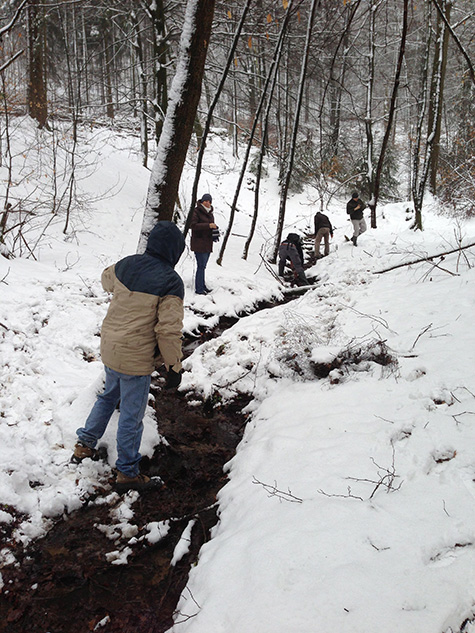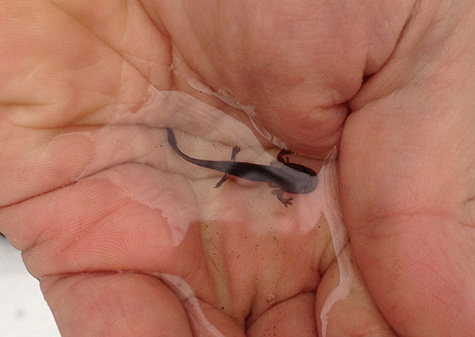
Every once in a while, a scientist comes upon a perfect setup for great science, one where nature poses a intriguing and important question that the scientist sees can be answered with the tools at hand. For biologist Alan Templeton, PhD, the setup was a fire salamander genus that can do “all sorts of crazy things” to adapt to changes in its environment.
One species of the fire salamander, Salamandra infraimmaculata, is found in the Middle East, where it sometimes lives in rock pools small enough to dry out after the rainy season ends. As true amphibians, the salamanders have an aquatic phase with gills and tiny legs and a terrestrial phase with lungs and stout legs.
The larval salamanders are able to sense when the water volume in their pond is dropping. Once the water drops, the clock is ticking. If the salamanders are to survive, they must morph to the terrestrial phase before the water disappears.
Here’s the crazy part. “What they’ll do when they sense the water volume dropping is start developing bigger heads,” Templeton said. “The largest larvae gets the biggest head so he can eat up all the smaller larvae to fuel his own metamorphosis. It’s called a cannibal morph.”
That’s just one of the many tricks the larval salamanders can pull to adjust their life histories to their circumstances. “Their developmental profile is very flexible,” Templeton said.
“One way to get a flexible developmental profile with the same set of genes is to turn genes on or off in a coordinated fashion in response to environmental cues,” he said.
Templeton and his colleagues recently received more than $2 million to look more closely at these shifting patterns of gene expression, called the salamanders’ transcriptomes.
An Israel-German-American collaboration
Templeton became involved in the conservation of two Israeli species, the fire salamander and the wild ass, through visiting professorships. He is currently a senior research associate and part-time professor of biology at the University of Haifa in Israel, as well as the Charles Rebstock Professor of Biology in Arts & Sciences at Washington University in St. Louis (soon-to-be professor emeritus).
“My Israeli colleagues and I started to study Salamandra infraimmaculata several years ago because this salamander is on the endangered species list there. We knew almost nothing about them,” he said.
“We actually found they are much more common than most people think, so they’re not endangered, but very little was known about their ecology and behavior.”
Leon Blaustein, PhD, an aquatic ecologist at the University of Haifa, began to study the salamanders’ ecology. (He did the experiment that showed larva can sense the water level in pools.) When Shirli Bar-David became a postdoctoral researcher in Blaustein’s lab, the group started to look at the salamanders’ genetics as well.

People studying salamanders tend to notice other people studying salamanders and soon Templeton and Blaustein were in contact with Sebastian Steinfartz of Bielefeld University in Germany who was studying Salamandra salamandra in the Kottenforst Nature Reserve near Bonn, Germany.
In 2013, Templeton, Blaustein, Steinfartz and Arne Nolte of the Max Planck Institute for Evolutionary Biology in Plön, Germany, won a prestigious Deutsch-Israel Project grant of 1.6 million Euros (more than $2 million) to study how both species of salamander shift their gene expression patterns to meet environmental challenges.
Shape-shifting salamanders
The two species of salamanders look very similar, Templeton said, but genetically they’re quite distinct. Moreover, they live at the extremes of the fire salamander’s range.
Larvae of the German species can be found in streams in snow-covered forests where the water is barely above freezing, and larvae of the Israeli species can live in temporary pools in arid regions that dry up once the rainy season is over.

Each species has many different larval habitats in its own country as well. “Salamandra infraimmaculata are found in streams, ponds, springs cisterns and rock pools. Their flexibility is amazing,” Templeton said.
“Those habitats are very different, so much so that most salamander species only live in one. Except in this genus, you almost never find salamanders in more than one habitat.
“But these species haven’t been looked at very much at the DNA level because their genome is much bigger than the human genome,” Templeton said.
The coding region, the part of the genome that is expressed, or transcribed, is about the same size as a human’s. But because salamanders have much more noncoding DNA, studying their genomics is difficult.
But studying salamander transcriptomes is as easy as studying human transcriptomes.
Nolte specializes in transcriptomics and Templeton also has enlisted the help of Sharlee Climer, PhD, a research assistant professor in computer science and engineering in the School of Engineering and Applied Science at Washington University in St. Louis, who has developed a computer program for looking at coordinated patterns of gene expression.

“Everything fell together perfectly,” Templeton said. “We had the people who could do ecological studies, field experiments, lab experiments and transcriptomics.” In fact, he said, the field season for salamanders (the rainy season) is mostly January and February in Israel, and the field season in German starts at the end of February. “So we can even have the same people involved in field studies in both countries.”
With luck, the team will reach a new understanding of the way interactions of the environment and genes rule the salamanders’ lives. The new dogma of modern biology? It’s not just about genes anymore.